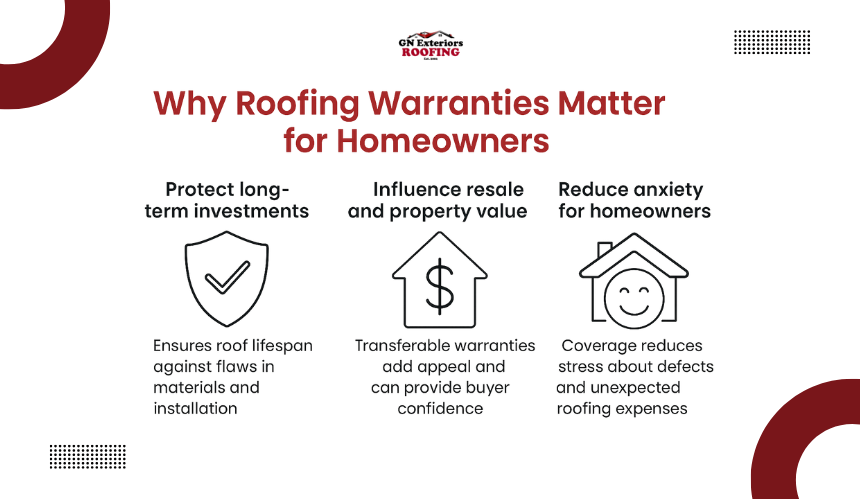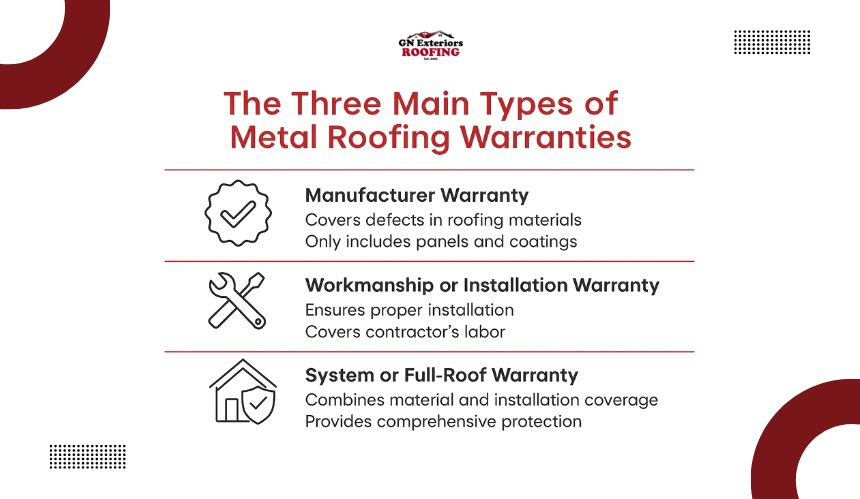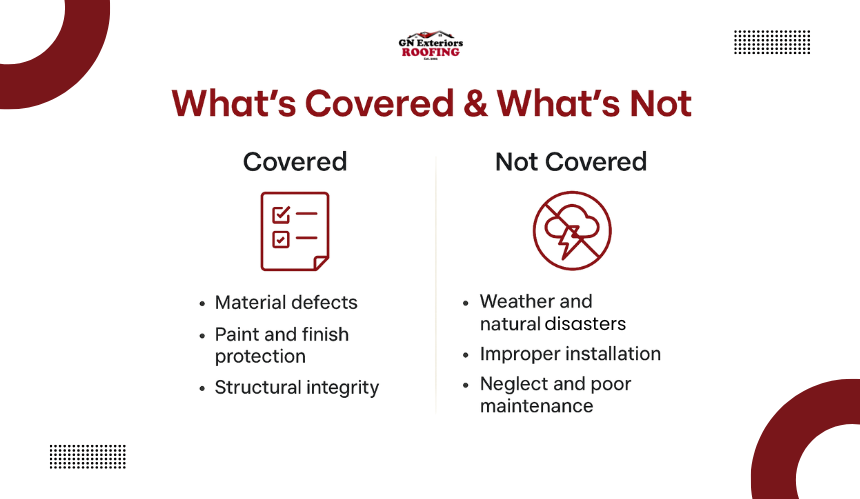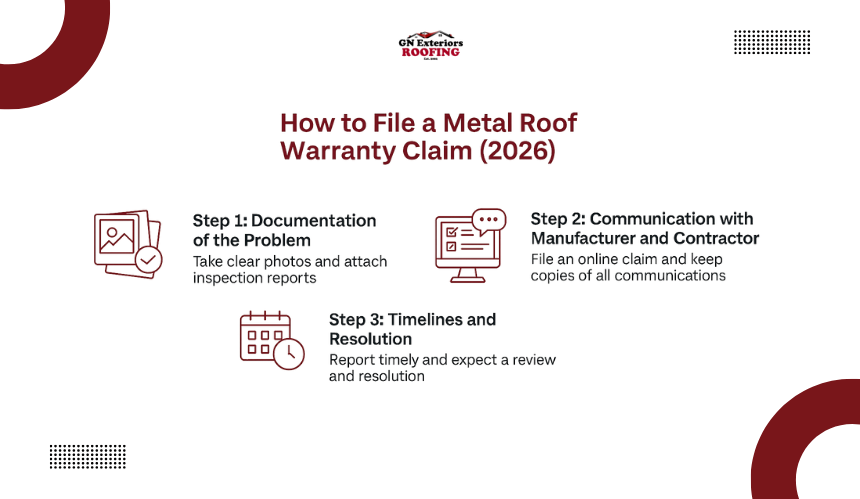
For many homeowners, investing in a metal roof is a long-term decision that balances durability, style, and protection for the property. Yet one factor that is often overlooked is the warranty that comes with the roof. A represents the promise of protection against defects, premature damage, or unexpected issues that could affect performance.
Some Warranties cover paint finish and structural integrity, while others only protect against specific types of defects. This 2026 homeowner guide provides a clear breakdown of metal roofing warranties, explaining the different types available, what homeowners can realistically expect from them, and how to avoid surprises when filing a claim.

When choosing a new roof, most homeowners look at style, cost, and durability. What often gets overlooked is the warranty that comes with the installation. Yet a roofing warranty can make the difference between a small repair expense and a major financial setback.
Metal roofs are designed to last far longer than traditional shingles, often 40 to 70 years with proper care. A warranty helps ensure that the expected lifespan is not cut short due to manufacturing flaws or installation mistakes.
A warranty provides written assurance that if something goes wrong within the coverage terms, the homeowner will not bear the full cost of repairs or replacement.
A home with a transferable roofing warranty often appeals more to buyers, since it demonstrates reliability and future cost protection. Buyers view it as added value, knowing they will not need to worry about premature roofing expenses. This makes a safeguard but also a selling point in competitive housing markets.
For many, a roof is the single most important barrier against weather damage. Having coverage in place reduces anxiety about potential defects or premature failures. Homeowners gain confidence knowing their investment is supported by both the product manufacturer and, in many cases, the roofing company that completed the work.

Not all warranties offer the same protection, and understanding the differences can help homeowners make more informed choices. Metal roofing warranties typically fall into three main categories, each covering specific aspects of materials and workmanship.
A manufacturer warranty is issued by the roofing product maker and applies specifically to the materials supplied. Its primary purpose is to guarantee that the roofing panels and coatings meet the company’s stated quality standards.
These warranties often run for several decades and may be prorated, meaning the level of coverage changes as the roof ages. They are limited to the manufacturer’s responsibility and do not include labor or installation errors.
Unlike manufacturer coverage, a workmanship warranty is offered by the metal roofing contractor. It guarantees that the roof was installed correctly and according to industry standards. If a problem arises due to improper installation, the contractor is responsible for repairs within the warranty period. However, this coverage does not usually extend to damage caused by weather, neglect, or outside interference.
A system or full-roof warranty combines both material and installation coverage into one package. It offers more comprehensive protection because it covers the roof as a complete system rather than individual parts.
This type of warranty is typically available through contractors who are certified by the manufacturer, ensuring the entire installation meets strict quality standards.

Every roofing warranty is designed with clear terms that outline what a homeowner can expect from their coverage. While the specifics vary by manufacturer and contractor, certain protections are commonly included in most agreements.
Metal roofing warranties often cover defects in the panels themselves. This includes premature cracking, splitting, or rusting that results from a flaw in the manufacturing process rather than outside factors. Coverage ensures that the roof performs as intended throughout its expected lifespan.
Many warranties provide protection for the roof’s painted or coated surface. This usually includes coverage against chalking, peeling, and fading beyond acceptable industry standards. Paint finish warranties can last decades, giving homeowners confidence that the roof will maintain both function and appearance.
Some warranties extend to issues related to the structural performance of roofing panels. This can include coverage for problems that affect load-bearing capacity or long-term stability due to defects in design or production. Ensuring structural integrity is critical since it impacts safety as well as durability.
Even the most comprehensive roofing warranties have limitations. Understanding what is excluded helps homeowners avoid costly surprises and ensures realistic expectations. Exclusions often reflect conditions that are outside the control of the manufacturer or contractor.
Events such as hail, hurricanes, tornadoes, and earthquakes are generally not included in standard warranties. These are considered acts of nature and are typically handled through homeowner’s insurance rather than warranty claims.
If the roof is installed by an unqualified contractor or altered by someone not approved by the manufacturer, the warranty can become void. Unauthorized repairs or modifications are viewed as risk factors that compromise the roof’s integrity.
Damage caused by lack of maintenance, accumulated debris, or misuse of cleaning chemicals is not covered. Warranties require homeowners to perform regular upkeep to preserve their validity.
Most warranties exclude coverage for damages to the interior of the home, personal belongings, or structural elements not directly related to the roofing materials. These additional costs often fall under insurance coverage instead.
Roofing warranties are often filled with technical terms and fine print. Learning how to evaluate them helps homeowners make informed decisions and avoid unpleasant surprises.
Phrases like “limited lifetime,” “prorated,” and “transferable” can drastically change the value of a warranty. Homeowners should know what each term means and how it affects long-term protection.
Every warranty includes conditions and limitations. Reading the fine print helps uncover what is left out, such as coverage that only applies under specific maintenance schedules or restrictions tied to regional climates.
Before signing, homeowners should ask clear questions about what is covered, how long the coverage lasts, and whether the warranty transfers to new owners. Having these details in writing ensures transparency.

When an issue arises, the claims process determines whether homeowners can actually benefit from their warranty. In 2026, manufacturers and contractors have adopted more structured and digitalized procedures to handle claims, which means homeowners must be more precise in how they prepare and submit requests.
Strong documentation is the foundation of a successful claim. Homeowners should take clear photographs of the issue from multiple angles and include both close-up and wide shots to show the extent of the damage.
Inspection reports prepared by a licensed roofing inspector add credibility, as they outline the cause and confirm that the problem is not due to neglect or outside interference. In 2026, some manufacturers now require these details to be uploaded through digital portals, so organizing documents in advance is essential.
A successful claim often requires coordination between the manufacturer and the contractor. The manufacturer is responsible for material defects, while the contractor covers installation-related issues under a workmanship warranty.
In 2026, many companies prefer written communication submitted through online claim forms, which provide a timestamp and reduce the chance of disputes.
Homeowners should keep copies of all emails, claim forms, and receipts in one place. This digital-first approach helps ensure claims are processed faster and leaves a clear record if disagreements occur.
Most warranties outline strict timeframes for reporting issues, often requiring claims to be filed within 30 to 90 days of the problem being discovered. In 2026, these deadlines have become more strictly enforced, with some companies automatically rejecting late submissions.
Once a claim is filed, manufacturers typically review it within a set number of weeks, followed by either approval, denial, or a request for more information. Resolution may involve material replacement, labor coverage, or a prorated reimbursement depending on the terms of the warranty.
Looking for expert guidance on your roofing investment? GN Exteriors is here to help homeowners choose the right materials, understand warranty coverage, and ensure long-lasting protection for their property. Contact the team today to get reliable roofing solutions backed by experience and trus
Improper installation, unauthorized repairs, and lack of routine maintenance are among the most common reasons a warranty can be voided. In 2026, more manufacturers also require documented inspections or maintenance records, meaning neglecting these conditions can lead to loss of coverage.
Many warranties are transferable, but the terms vary. Some allow only a one-time transfer to the next owner, while others set specific deadlines for notifying the manufacturer about the change in ownership. Transferable warranties can also increase a home’s resale value.
A lifetime warranty typically lasts for the duration of the homeowner’s ownership of the property. A prorated warranty offers coverage that decreases in value over time, often providing full protection in the early years and reduced compensation later. Knowing the difference helps homeowners calculate long-term protection.
Yes. While warranties generally cover manufacturing or installation defects, homeowner’s insurance covers external damage from storms, fire, or accidents. Together, they create a broader safety net, ensuring both product flaws and unexpected disasters are addressed.